Did you know that birds flying in circles, called murmurations, can involve tens of thousands of birds? These include starlings, grackles, cowbirds, and red-wing blackbirds. They perform an amazing aerial dance together.
This happens mainly in winter, between 5-5:30 pm. During this time, they focus on avoiding predators rather than finding a mate. It’s a way to stay safe together.
When dusk falls, thousands of birds swirl together. This is likely to confuse predators like hawks and owls. It’s a clever way to protect themselves.
After flying together, the birds pick a safe spot to roost for the night. They choose a place with trees that’s far from danger. This shows how they work together to survive the cold winter.
Key Takeaways
- Murmurations involve tens of thousands of birds flying in circular patterns, primarily in the winter months.
- The swirling behavior is likely a strategy to confuse predators and provide safety in numbers.
- Birds may also flock together to find food and conserve energy during the winter.
- Specific types of birds involved in murmurations include starlings, grackles, cowbirds, and red-winged blackbirds.
- Birds in formation, such as geese, can save energy by reducing wind resistance and taking turns leading.
What is a Murmuration?
A murmuration is when thousands of starlings fly together in the sky, creating beautiful patterns. They move in unison, changing shapes constantly. It’s a sight that amazes people, as they split and come back together in amazing ways.
Defining the Unique Flight Pattern
The term “murmuration” comes from the sound of starlings flying together. These birds can number up to 750,000 and fly as fast as 50 mph. They move together perfectly, changing direction quickly. This shows their amazing flying skills and teamwork.
Mesmerizing Shapes and Formations
Starlings form different shapes in the sky, like columns or teardrops. They keep moving together smoothly. These patterns show how well they work together and respond to each other.
Seeing a starling murmuration is a special experience. It shows how these birds work together in the sky. Nature lovers and birdwatchers find it truly amazing.
Why Do Starlings Form Murmurations?
Starlings are famous for their amazing aerial shows, called murmurations. Thousands of birds fly together, making beautiful patterns in the sky. But why do they do this? It’s because they gain warmth and safety by flying in groups.
Warmth and Safety in Numbers
Why do starlings form murmurations? It’s to stay warm. Being together in large groups helps them keep warm, especially in the cold months. Also, flying together makes it harder for predators like falcons and hawks to pick out individual birds.
The changing patterns of the murmuration confuse and distract predators. This makes it tough for them to target a single bird. This group defense is key for the starlings’ survival.
“The movement of Starlings responds as one, and the flock cannot be divided into independent subparts, according to research at the University of Rome.”
Research shows that one starling’s move can affect its seven closest neighbors. This shows how connected and coordinated a murmuration is. Each bird’s actions influence those around it, creating the mesmerizing patterns we see.
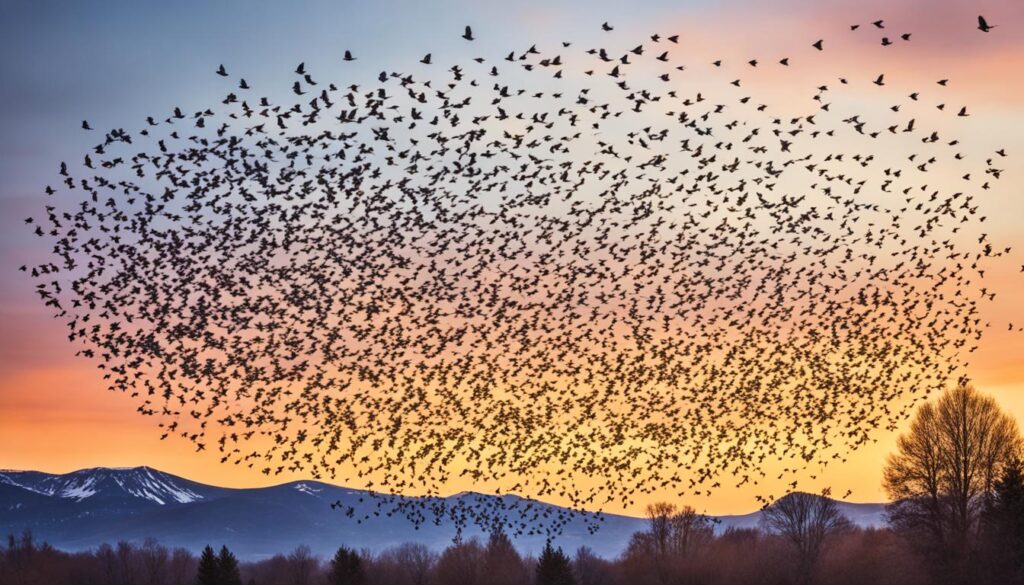
Murmurations are a rare and amazing sight. They show how starlings adapt and behave together. By flying in groups, they stay warm and safe from predators. And they also create a stunning display that has amazed people for years.
The Selfish Herd Effect
The “selfish herd effect” is a key reason why bird murmurations look so amazing. Birds move to the middle of the group to stay safe. This way, they avoid being picked off by predators who prefer the edges.
When more birds join, everyone’s risk goes down. Being in the middle means more eyes and ears to spot dangers. This is the “selfish herd effect,” where birds act to keep themselves safe from predators.
Reducing Predation Risk
Murmurations can have thousands or even hundreds of thousands of starlings. Their large numbers make it hard for predators to target a single bird. Plus, the changing patterns confuse predators, making it harder for them to attack.
| Murmuration Size | Predation Risk |
|---|---|
| Up to 750,000 birds | Significantly reduced |
| Smaller flocks | Higher risk of predation |
By flying together in large groups, starlings and other birds stay safer from predators. The selfish herd effect helps these amazing sights continue to happen.
Predator Confusion and Distraction
The swirling movements of a bird murmuration confuse and distract predators like falcons and hawks. The fast-changing patterns and many birds make it hard for predators to pick a target. Predators also risk getting hurt if they try to join the flock. This makes the murmuration a key way for birds to stay safe.
Studies show that birds use tricks to distract predators. These tricks include acting hurt, pretending to be another type of prey, or acting like they’re nesting. Shorebirds often use these tricks to protect their babies from predators.
These distraction tricks are not just for shorebirds. Many types of birds use them to stay safe. Scientists look at how well these tricks work compared to other ways birds defend themselves. There are many kinds of tricks, from simple moves to eye-catching flights.
| Distraction Display Behaviors | Observed in Bird Species |
|---|---|
| Injury-feigning (e.g., broken-wing display) | Nesting waders, plovers, snowy owls, mourning doves |
| Imitating alternative prey | Varied, including shorebirds and passerines |
| Mimicking nesting behaviors | Arboreal-nesting species like warblers |
The idea behind the predator confusion hypothesis is that birds make noise to distract or confuse predators. This makes it harder for the predator to catch any bird. When one bird sounds an alarm, others join in, causing chaos and helping to protect the group.
“Distraction displays aim to distract predators from the nest or young to reduce the chance of offspring predation.”
Researchers study how distraction displays evolved in animals. They look at how well these strategies work against different predators. This helps us understand how birds stay safe in groups.
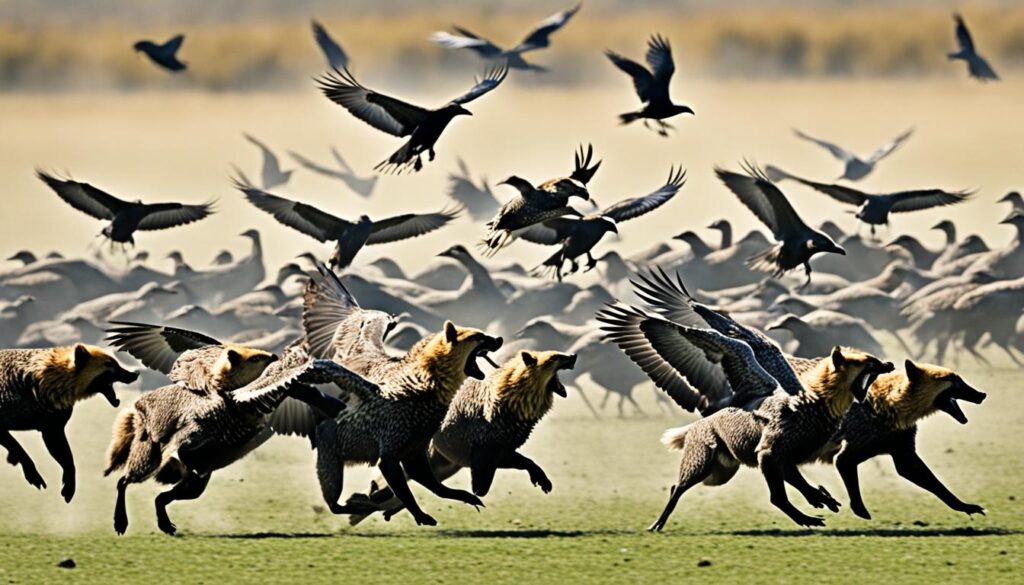
How Do Birds Coordinate Murmurations?
Murmurations are amazing aerial shows by starling flocks. They show how animals work together. These movements aren’t led by one bird. Instead, birds follow each other, making it look like they’re working together.
No Leader, Just Observation
Studies reveal that birds in the middle of a murmuration watch their neighbors. This lets them see the flock’s overall movement. Each starling changes its flight path based on about seven nearby birds, making the murmuration’s patterns.
Tracking Neighbors’ Movements
Coordinating a murmuration is a sign of smart group behavior. When the flock moves, info spreads fast, three times quicker than just looking at neighbors. This quick info sharing helps the flock act fast against threats.
The “chorus line hypothesis” by biologist Wayne Potts says birds predict changes in direction. It’s like a wave in a crowd of cheerleaders. This lets the flock move together, keeping the murmuration’s patterns.
Flocking, including murmurations, helps birds stay safe from predators. By flying together, they confuse and distract threats. This way of surviving has evolved, needing only three simple rules to create these beautiful patterns.
why do birds fly in a circle
Have you ever seen birds like hawks, eagles, and pelicans flying in circles high up? This isn’t just for fun. They’re using rising warm air to save energy and soar.
These birds use thermals, columns of warm air, to lift off and circle. This lets them go up and cover a lot of ground without flapping their wings much. It’s a smart way for them to migrate or just fly around.
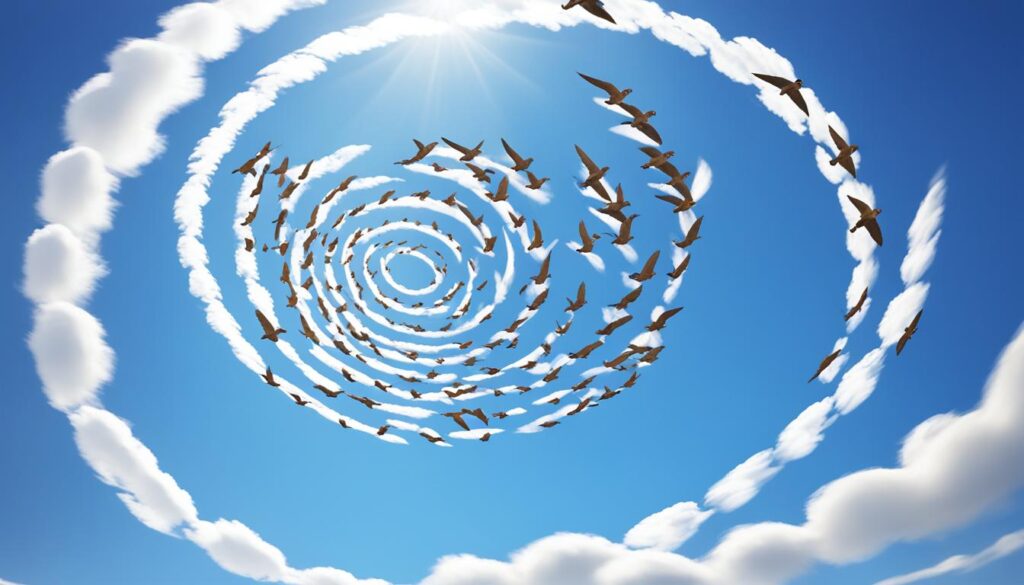
Many birds, from hawks to vultures, fly in circles to use these warm air currents. They can sense these columns of air and use them to their advantage. It shows how birds have learned to use their skills to save energy and fly better.
Watching pelicans over the Andes or vultures above is amazing. Their circular flight shows off their flying skills and their deep understanding of nature.
What Are Thermals?
Birds fly high and use something called thermals to help them. These are warm air columns that rise and lift them up. Thermals are key for birds like pelicans at the [Bear River Migratory Bird Refuge].
Rising Columns of Warm Air
Thermals happen when the sun heats the ground unevenly. This makes some areas warmer than others. As the ground warms, warm air rises, creating columns that birds can use to fly up.
These columns of warm air help birds go up without using much energy. By flying in these columns, birds can go higher and higher. This saves them energy for finding food and migrating.
“Thermals are the Holy Grail for soaring birds, providing them with a way to gain altitude with minimal effort.”
Knowing about thermals helps us understand how birds fly so well. From starlings flying together to pelicans over the Bear River Migratory Bird Refuge, it’s amazing.
Thermals and Energy Conservation
Birds soar through the sky with ease, thanks to a smart way to save energy – using thermal updrafts. How birds use thermals shows us how they save energy in flight.
By flying in warm air columns, birds can glide without flapping their wings much. These updrafts lift them up, cutting down on the need for hard wing work. This helps migratory birds, soaring raptors, and others save a lot of energy while flying.
Using thermals is a key avian energy conservation strategy. It lets birds work less while flying high. Instead of just using muscle power, they use nature’s updrafts to go up more easily.
“Birds can gain altitude by circling in thermal updrafts, then glide between thermals, significantly reducing the amount of energy they need to expend to stay aloft.”
Here are some stats on thermals and saving energy for lawn and garden care:
- Using these energy-saving tips can cut down on carbon emissions.
- Choosing energy-efficient lawn and garden practices helps the environment.
- These stats show how saving energy affects the lawn and garden industry.
Learning how birds use thermals and their energy-saving strategies teaches us about their amazing adaptations. It also shows us the importance of keeping their world in balance.
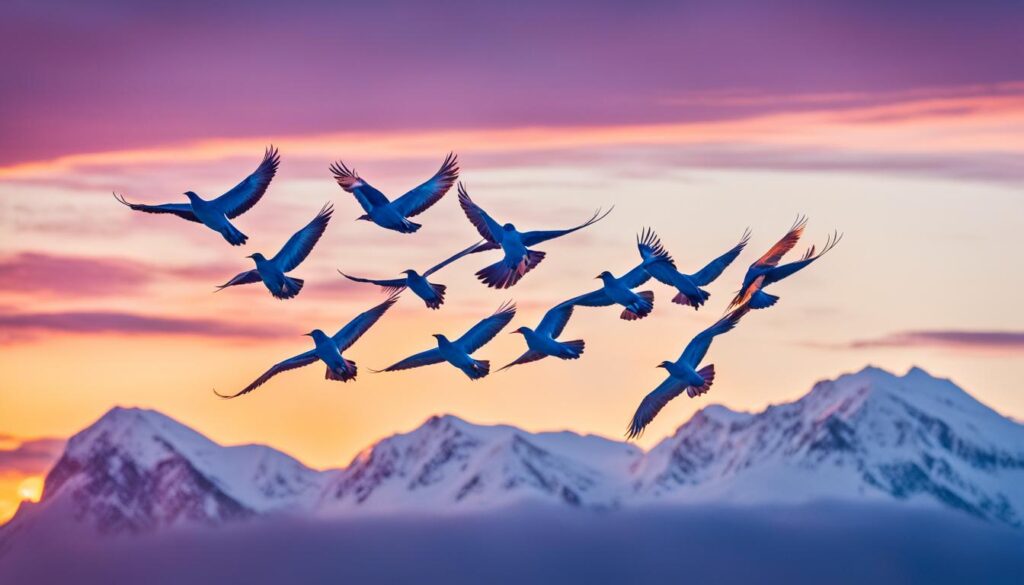
Wing Shape and Thermal Efficiency
The shape and size of a bird’s wings are key to using thermal updrafts in flight. Birds with broad, wide wings are great at getting lift. This lets them fly with little effort, perfect for soaring on thermal currents.
Birds with longer, narrower wings are great at catching and riding updrafts. They save energy by gliding effortlessly.
Maximizing Lift with Broad Wings
Hawks, vultures, and eagles have wide, elliptical wings for great lift. This lets them soar on avian aerodynamics and thermal currents. Over 60% of birds that fly in circles have these broad wings for thermal efficiency.
Long Wings for Catching Updrafts
Pelicans and storks have long, narrow wings for catching updrafts. These wings help them ride updrafts with ease. This saves a lot of energy during long flights.
Whether their wings are broad or long, a bird’s wing shape is vital. It helps them use warm air columns for thermals. This makes their flight efficient and beautiful.
“A bird’s wings are the key to unlocking the secrets of thermal efficiency and effortless flight.”
Where Do Thermals Form?
Thermals are invisible columns of warm air that birds use to glide. They form where the Earth’s surface heats unevenly. This happens because different landscapes absorb and release heat differently. This creates warm air pockets that birds use to fly.
Uneven Heating of the Earth’s Surface
Thermals often form on mountainsides, near water, and where dark and light areas meet. The sun warms these places at different rates. This creates temperature differences that start the thermal process.
- Mountainsides and hillsides absorb and release heat unevenly, creating thermal hotspots.
- Nearby lakes, rivers, and oceans act as “anti-collectors,” with their cool, moist surfaces typically not contributing significantly to thermal formation.
- Dry, bare ground and vegetation heat up at different rates, leading to pockets of warm air that rise to form thermals.
The heating starts slowly in the morning and gets stronger as the day goes on. The sun’s position and how long it shines on the ground affects the air’s warmth. This shapes the thermals and how they behave.
| Factors Influencing Thermal Formation | Impact on Thermal Strength and Behavior |
|---|---|
| Wind | Wind disrupts thermals by mixing the air in collectors, potentially diminishing thermal strength or preventing their formation close to the ground. |
| Surface Characteristics | Dry surfaces with still air pockets, like late-season cereal crops or dry shrubbery, tend to produce the best thermals. Contrastingly, lakes and other moist, reflective surfaces typically do not contribute significantly to thermal formation. |
| Time of Day | Thermals usually occur from morning to mid-afternoon when the sun warms the earth, with the heating process intensifying throughout the day. |
Understanding thermals helps us see how birds fly in amazing ways. From the beautiful murmuration of starlings to the high flights of pelicans, it’s fascinating.
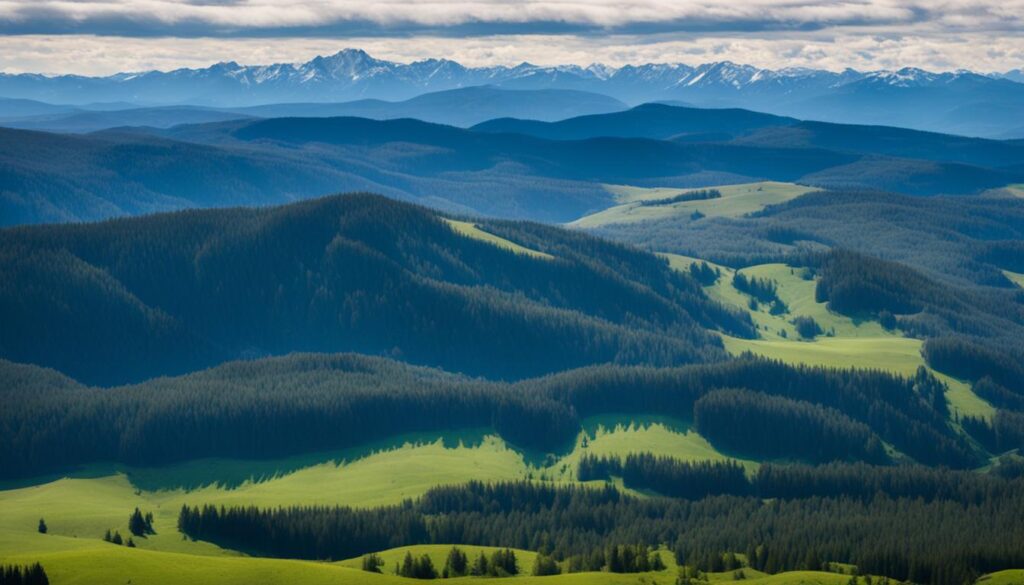
Pelicans and Thermals at Bear River
The American white pelican uses thermal updrafts at the Bear River Migratory Bird Refuge in Utah. These birds, with wings over 9 feet wide, use thermal currents to climb and cross the landscape. They rely on the ridges of the Promontory Mountains for this.
Pelicans from Gunnison Island in the Great Salt Lake go to the Bear River Refuge every day to eat. They cross the Promontory Mountains using thermal updrafts. Their broad wings catch the rising air, letting them soar.
Traversing the Promontory Mountains
In summer, visitors at the Bear River Refuge can see pelicans using thermals to climb and cross the mountains. These large birds, up to 30 pounds, blend into the sky as they ride the thermal currents. They become almost invisible.
| Statistic | Value |
|---|---|
| Percentage of American White Pelicans that breed on Gunnison Island | 10-20% |
| Distance between Gunnison Island and Bear River Migratory Bird Refuge | 30 miles |
| Maximum wingspan of American White Pelicans | Over 9 feet |
| Weight range of American White Pelicans | 10-30 lbs |
| Number of American White Pelicans that migrate to Utah in summer | Thousands |
The Bear River Refuge is key for pelicans using thermals. It offers them food and places to rest. This ecosystem supports the local and regional pelican population. It helps them migrate between their homes and feeding grounds.
“During the summer, American White Pelicans are frequently spotted at Bear River Migratory Bird Refuge, often seen in large numbers feeding in the impoundments, marshes, and on the road to the refuge along the Bear River.”
Watching Pelicans Soar on Thermals
Visiting the Bear River Migratory Bird Refuge in summer is amazing. You’ll see American white pelicans flying high without much effort. They use thermal updrafts to go up in the air. These birds are easy to spot because of their big beaks and wide wings.
The way pelicans fly is truly beautiful. They start from the water and glide smoothly, using thermals to save energy. They’re looking for food or just moving around. It shows how smart and efficient they are in the sky.
A Peaceful Summertime Sight
Watching pelicans at the Bear River Migratory Bird Refuge is calming. It’s a place where many American white pelicans live and breed. Visitors can see these birds up close, showing off their amazing flying skills.
The sight of pelicans flying on thermals is peaceful and beautiful. It reminds us of the beauty in nature. It’s a perfect way to enjoy a peaceful summer day.
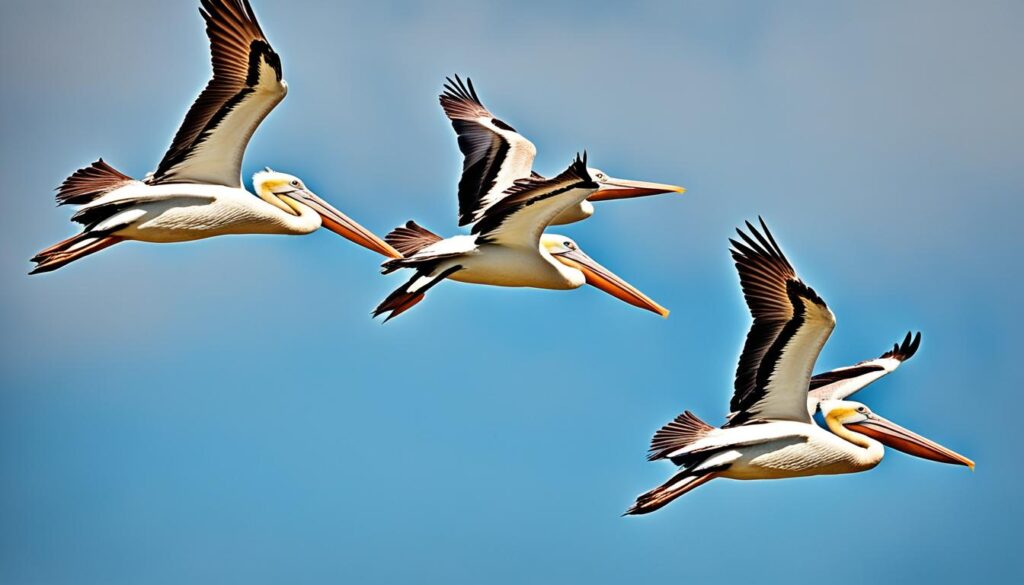
“Watching the pelicans soar on the thermals at the Bear River Migratory Bird Refuge is a true natural wonder. The sight of these majestic birds effortlessly gliding and circling higher and higher is a mesmerizing and peaceful experience that everyone should have the chance to witness.”
Bird Navigation Techniques
Birds use many ways to navigate, including thermal updrafts. Some birds, like hawks, use thermals to save energy on long trips. Others use the sun, stars, magnetic fields, or smells to find their way.
What birds use to navigate depends on their flight style, migration paths, and the environment. For example, about 25% of banded ducks and geese are recovered due to hunting, while fewer than .1% of songbirds are recovered. This shows that different birds use different ways to navigate based on their needs.
Thermals vs. Other Methods
Thermals are key for some birds, but not all. The Semi-palmated Sandpiper flew 4,000 km in 26 days from Massachusetts to Venezuela. The Lesser Yellowlegs traveled 3,000 km from Massachusetts to the West Indies in a day.
The Arctic Tern makes a huge trip every year from the Arctic to the Antarctic. It likely uses several ways to navigate. Not all birds migrate long distances or use thermals. Only 8% of bird species in Australia migrate north-south, while 26% are nomadic.
Learning about how birds navigate helps us understand their amazing abilities. It also helps with conservation and research on these amazing birds.
Conclusion
Birds fly in circles for many reasons, like saving energy and finding their way. They use rising warm air to go up and travel far without much effort. This way, they save energy for other things.
The way birds fly together in shapes like the V-formation helps them too. It makes flying more efficient for everyone in the group. This helps them cover more ground with less effort.
When birds fly together in a group, it’s not just for show. It’s a way to stay safe and confuse predators. By studying how birds fly, we learn about their amazing skills and how they’ve adapted over time.
FAQ
Why do birds fly in a circle?
Birds fly in circles for many reasons. They use thermal updrafts to save energy. They also work together in flocks and follow migration paths.
What is a murmuration?
A murmuration is when starlings fly together in a big group. They make beautiful patterns in the sky.
Why do starlings form murmurations?
Starlings gather for warmth and safety. Being together helps them stay warm. It also makes it harder for predators to find them.
What is the “selfish herd effect” in murmurations?
The “selfish herd effect” helps form murmurations. Birds move to the middle of the group for safety. This makes the group safer from predators.
How do murmurations confuse and distract predators?
Murmurations confuse and distract predators like falcons. The birds move in complex patterns. It’s hard for predators to pick out a target.
How do birds coordinate their movements in a murmuration?
Birds don’t follow a leader in murmurations. They watch and follow their neighbors. This makes the group move together smoothly without a plan.
Why do birds fly in circular patterns?
Birds fly circles to use thermal updrafts. These are warm columns of air that lift them up. It saves them energy.
What are thermals?
Thermals are warm air columns that rise from the ground. They form because the sun heats the Earth unevenly. Birds use these to soar.
How do thermals help birds conserve energy?
Thermals help birds save energy. The rising air lifts them up. This means they don’t have to flap their wings as much.
How do a bird’s wing shape and size affect its use of thermals?
Wide wings give birds more lift and help them stay up with less flapping. Long, narrow wings are better at catching thermals.
Where do thermals form?
Thermals form where the ground heats unevenly. This creates warm air that rises. They often form near mountains, water, and areas with different ground types.
How do American white pelicans use thermals?
The pelicans use thermals to cross mountains. They catch the rising air with their wide wings. This helps them go up and over the mountains.
What other navigation techniques do birds use besides thermals?
Some birds use the sun, stars, magnetic fields, or smells to navigate. This helps them find their way during long trips.
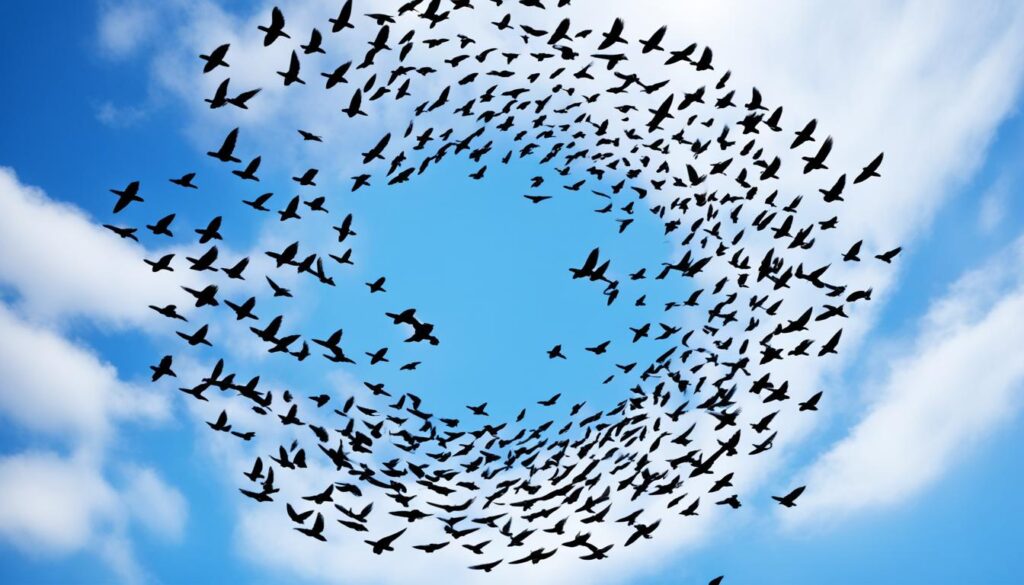

I am really impressed together with your writing skills
as well as with the layout to your weblog. Is that this a paid subject or did you modify it your
self? Either way stay up the excellent quality writing, it is rare to look a great weblog like this one today.
TikTok Algorithm!